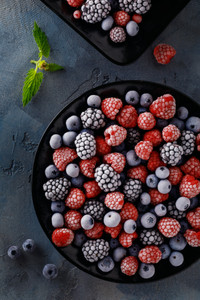Freezing fruit
Posted by The Wares Team on 30th Sep 2020
There’s a bit of a theme running through our blog posts currently - how to store and make the best use of the abundant harvest of fresh fruit and vegetables that many of us are enjoying from our own gardens currently. Even those without gardens can share the joy because there is so much fresh produce available right now in greengrocers and supermarkets, much of it produced locally at this time of year. With news of further pandemic lockdown restrictions and the threat of Brexit-induced disruption at the end of the year, there really is no wonder that people are seeking sanctuary in their kitchens and stocking up for the coming months like never before. In today’s blog post, we are looking at one of the fastest and easiest ways to process a glut of garden produce - freezing.
Whether you have a fridge-freezer in your kitchen or a couple of large
chest freezers in your garage or outhouse, freezing is an efficient way
of storing food for use throughout winter. Here’s how to plan and prep a
major freezing session:
Can I freeze food in jam jars?
Before we go into detail about how best to freeze your fruit and veg
crops, we need to get to the bottom of the myth that freezing in glass
food jars is not a good idea. Many people believe that if you use jam
jars and other glass food jars to freeze stuff, you run the risk of the
jars cracking or even exploding, ruining the contents, and potentially a
lot of other items in the freezer at the same time. Whilst there is
some truth to this belief, it’s not quite as straightforward as that. It
might not be the best idea to use regular jam jars for freezing items,
but there are glass food jars available that are made from tempered
glass, which can withstand freezing, and so these are perfectly safe to
use in the freezer. As well as using the right kind of jar, it’s
important always to leave a generous gap at the top of the jar, to give
enough room for expansion as the contents freeze. That will avoid any
risk of the glass cracking during the freezing process.
Freeze now, fill those jam jars later
Another myth that needs to be debunked is that you need to make jam and
chutney with fresh fruit or veg, rather than frozen. While it is true
that there are some fruit and vegetables that just don’t freeze well,
there are still plenty of items that will be perfectly fine in the
freezer, until you are ready to make your preserves. So if you’re
planning to give some of your jams, jellies, pickles and preserves as
gifts this Christmas, why not store your fruit and veg in the freezer
until you have enough time to do a batch of preserving? So, for example,
with so many apple and plum trees laden with fruit right now, just
waiting to be picked, why not gather in your harvest, prep it and pack
it in sensibly-sized portions, and then freeze it ready for use over the
coming weeks? If you’re in a part of the UK where the blackberry
harvest is still in full swing, you could pick a good haul of those too,
and then make apple and blackberry jam using frozen fruit once the
harvesting period is over.
As we’ve mentioned in a previous post, it actually helps in the process
of making sloe gin if the sloes are frozen before being added to the
gin. This process, known as ‘bletting’ helps sloe gin achieve maximum
flavour. Another hedgerow staple that will also freeze well until you’re
ready for it is rosehips. Just gather them now, freeze them promptly,
and then retrieve from the freezer to make a spectacular rosehip syrup
that is way better than the syrup you remember from school days. Pour
rosehip syrup over ice-cream or stir it into Greek yoghurt for a
scrumptious treat. And of course, homemade rosehip syrup will make a
great gift for Christmas, presented prettily in a long-necked bottle,
with a cute label around the neck.
We’ve mentioned apples already, but if you’re still looking for ideas on
how to use your crop up, why not juice a batch and then store the juice
in the freezer? Nothing beats your own fresh apple juice, and it’s
packed with goodness that is undiminished by the act of freezing. That
means it’s a great way to get a daily dose of vitamins long after the
apple harvest is over.
How has your growing season gone? Are you having a bumper harvest or
have some of your crops been a little lacklustre with the all-or-nothing
weather we’ve had through the summer? Either way, we’d love to hear
your stories of how your fruit and veg growing has gone this year, and
what you plan to do with your produce. Get in touch via Twitter,
Instagram or Facebook to share your adventures!

